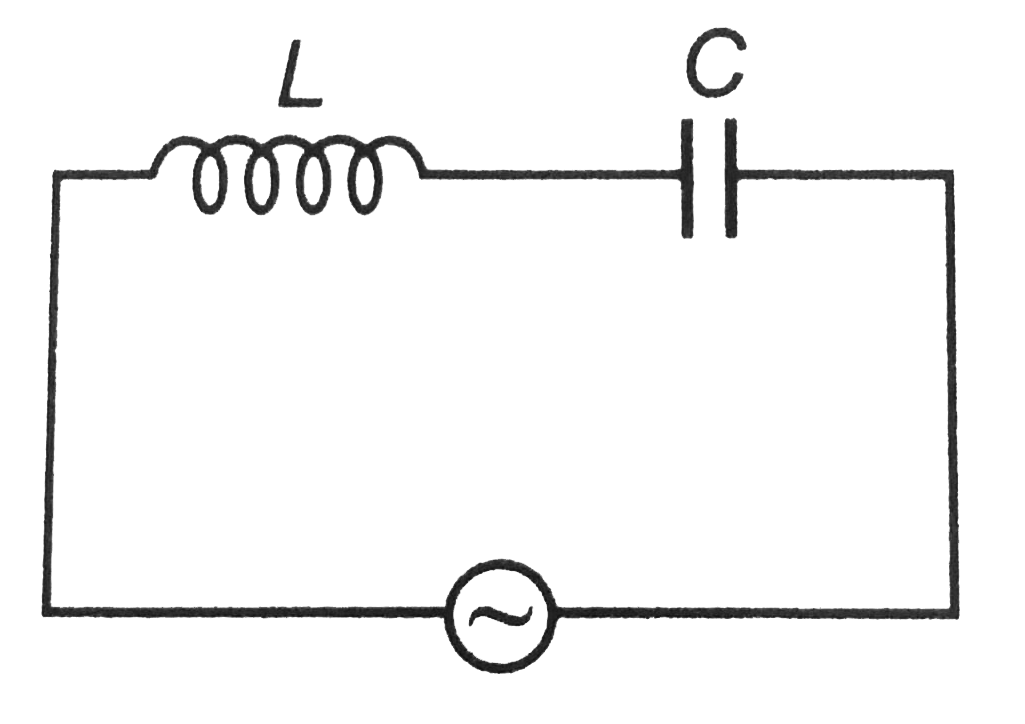Answer the following questions :
(a) In any a.c. circuit, is the applied instantaneous voltage equal to the algebraic sum of the instantaneous voltages across the series elements of the circuit ? Is the same true for rins voltage ?
(b) A capacitor is used in the primary circuit of an induction coil.
(c) An applied voltage signal consists of a superposition of a d.c. voltage and an a.c. voltage of high frequency. The circuit consists of an inductor and a capacitor in series. Show that the d.c. signal will appear across C and the a.c. signal across L.
(d) A choke coil in series with a lamp is connected to a d.c. line. The lamp is seen to shine brightly. Insertion of an iron core in the choke causes no change in the lamp's brightness.
Predict the corresponding observations if the connection is to an a.c. line.
(e) Why is choke coil needed in the use of fluorescent tubes with a.c. mains ? Why can we not use an ordinary resistor instead of the choke coil ?
(a) Yes, the applied instantaneous voltage is equal to the algebraic sum of the instantaneous voltages across the series elements of the given a.c. circuit. The same is not true for rms voltage, because voltages across different elements may not be in phase.
(b) Out of syllabus.
(c) For d.c., impedance of L is negligible and of C very high (infinite), so the d.c., signal appears across C. For high frequency a.c., impedance of L is high and that of C is low. So, the a.c., signal appears across L.
(d) For a steady state d.c., inductance of the choke coil has no effect, even if it is increased by inserting an iron-core. For a.c., the lamp will shine dimly because of additional impedance of the choke. It will dim further when the iron core is inserted which increases the choke.s impedance. br> (e) A fluorescent tube needs less current for discharge (glow) to take place. A choke coil joined with fluorescent tube reduces the current flowing because in an a.c. circuit the choke offers an inductive reactance X1. However, power consumed by choke is negligible because current
and voltage in choke coil differ in phase by π2 . Thus, we save in power.
If we use an ordinary resistor instead of a choke coil with the fluorescent tube, no doubt current in the circuit will fall to the desired level. However, it involves loss of power π2 Thus, the fluorescent tube will consume more power.
Topper's Solved these Questions
- ALTERNATING CURRENT BOOK - U-LIKE SERIESCHAPTER - ALTERNATING CURRENT EXERCISE - CASE BASED/SOURCE-BASED INTEGRATED QUESTIONS
19 Videos
- ALTERNATING CURRENT BOOK - U-LIKE SERIESCHAPTER - ALTERNATING CURRENT EXERCISE - MULTIPLE CHOICE QUESTIONS
34 Videos
- ALTERNATING CURRENT BOOK - U-LIKE SERIESCHAPTER - ALTERNATING CURRENT EXERCISE - SELF ASSESSMENT TEST (SECTION -C)
2 Videos
- ATOMSBOOK - U-LIKE SERIESCHAPTER - ATOMSEXERCISE - SELF ASSESSMENT TEST (SECTION C)
2 Videos
Similar Questions
Answer the following questions :
(a) In any a.c. circuit, is the applied instantaneous voltage equal to the algebraic sum of the instantaneous voltages acorss the series elements of the circuit ? Is the same true for r.m.s. voltage?
(b) A capacitor is used in the primary circuit of an induction coil.
(c ) An applied voltage signal consists of a superposition of a d.c. voltage and an a.c. voltage of high frequency. The circuit consists of an inductor and a capacitor in series. Show that the d.c. signal will appear across C and the a.c. signal will appear across L.
(d) A choke coil in series with a lamp is connected to a d.c. line. The lamp is seen to shine brightly. Insertion of an iron core in the choke causes no change in the lamp's brightness. Predict the corresponding observation if the connection is to an a.c. line.
(e) Why is choke coil needed in use of fluorescent tubes with ac mains ? Why can we not use an ordinary resistor instead of choke coil?
View SolutionIn a series L−C circuit, the applied voltage is V0. if omega is very low, then the voltage drop across the inductor VL and capacitor VC are
 .
.
View Solution
Knowledge Check
In an a.c. series circuit, the instantaneous current is maximum when the instantaneous voltage is maximum. The circuit element connected to the source will be
APure inductorBPure capacitorCPure resistorDcombination of capacitor and an inductor.In an LCR series a.c. circuit, the voltage across each of the components L, C and R is 50 V. The voltage across the LC combination will be
A50 VB50√2 VC100 VD0 VIn an LCR series a.c. circuit, the voltage across each of the components L,C, and R is 60 V. What is the voltage across the LC combination ?
A60 VB120 VCzero VD60√2V
In an AC circuit, voltage V = V0sinωt and inductor L is connected across the circuit. Then the instantaneous power will be
View SolutionIn an AC circuit, voltage V = V0sinωt and inductor L is connected across the circuit. Then the instantaneous power will be
View SolutionIn a series L−C circuit, the applied voltage is V0. if omega is very low, then the voltage drop across the inductor VL and capacitor VC are
 .
.
View SolutionIn an L-C-R circuit, if V is the effective value of the applied voltage VR is the voltage across R, VL is the effective voltage across L, VC is the effective voltage across C, then
View SolutionIf A.C. voltage is applied to a pure capacitor, then votage across the capacitor ………….. .
View Solution
